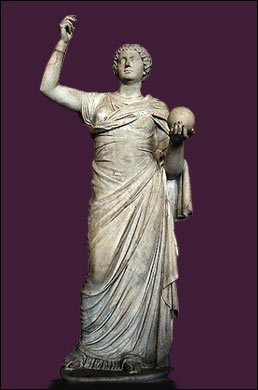| |
|
| |
|
| |
| |
Athena carried immortal Pegasos to Boetia’s woody Helikon, (Elikón, meaning: spiral) a Mount in central Greece and a place Pausanias reverently described as the most forested of regions  . Helikon, a serene god-spirited mountain sacred to Apollo was the demesne of the Muses. “Their soft feet move in the dance which rings the violet-dark spring beneath the altar of mighty Zeus” wrote poet and mythologist Hesiod, describing spring, site, and Muses. . Helikon, a serene god-spirited mountain sacred to Apollo was the demesne of the Muses. “Their soft feet move in the dance which rings the violet-dark spring beneath the altar of mighty Zeus” wrote poet and mythologist Hesiod, describing spring, site, and Muses.
|
|
|
| |
With the arrival of Pegasos we may wonder what thought then Melpomene upon discovering the seed of slaughter upon her path ? |
|
|
|
| |
Athena tamed the wild colt before placing his education under the aegis of the Muses — “who rule all minstrelsy” — daughters of Zeus and Mnemosyne, goddess of memory. The nine sisters trained under Apollo their protector : Urania, Erato, Thalia, Clio, Polyhymnia, Melpomene, Euterpe, Terpsichore and Calliope — the eldest and most influential — *11  . We find them laurel-crowned within El Djem’s House of the Months, Tunisia. |
|
|
|
| |
O happy Muses! who, safe from cares on this fair hill reside.
Blest in your seat, and free yourselves to please
With joys of study, and with glorious ease.
(Athena speaking through the stylus of Ovid). |
|
|
|
| |
“Concordant of heart, singing is all the thought passing in them. No care troubles their spirits” .*6 The gentle Muses so cherished the wild, unapproachable colt, he somewhat relented, allowing their light touches in moments of affection, especially Urania, Muse of Astronomy  . Patting her garments within which shimmered the constellations, she foretold his future heroism accompanying celestial emplacement. |
|
|
|
|
Pegasos was not alone a pupil of the Muses. Sphinx was present too, memorizing riddles with a lisp. Aristaeus studied healing and prophecy, Musaeus, poetry and oracles, whilst Echo the nymph studied music. |
|
|
|
| |
Education then stressed music, mousike, however this term signified a training encompassing all liberal arts, mathematics included. Plato — no doubt prompted by Muse Euterpe — explained physical training developed fortitude whilst music and appreciation of beauty were disciplines beneficial to philosophy. He prophetically stated were rulers to countenance poor quality music, their citizens’ mental and moral balance would soon retire.During this period Pegasos may have witnessed exchanges between Hermes and Apollo whereby the former gifted Apollo with the linen-corded lyre and in return received the twining caduseus. To honor the Muses the lyre was strung with nine cords. |
|
|
|
| |
Hesiod (8th century BC) rumour claimed, found himself graciously initiated by the Muses. At Mount Helikon he deservedly received a poet's staff alongside a sprig of myrtle. Drinking sacred spring-waters gifted him with divine poetry and prophecy. Plato termed such “poetical madness”, a condition which could but come from the Gods. Perhaps the sculptor Onestos also drank of these waters since in their sanctuary he carved nine statues, one of each Muse. It was no surprise the artist composed poetry as well. |
|
|
| |
 |
|
| |
It followed that in Helikon's valley of the Muses, Pegasos matured into the loyal companion of poets. His nobleness inspires till this day and he is known to all.
|
|
|
| |
|
|
| |
|
|
|
| |
|
|



